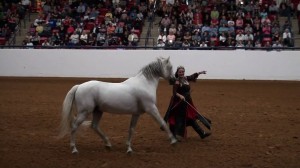I started this article after a trip to Chicago with Leo Lastre. We were organizing a joust to be held at the end of the summer and I was fortunate enough to visit several of Leo’s friends that he had made in the horse community. This where I had my first extended exposure to stallions. Leo introduced me to Laura Amandis and arranged for me to take a lesson from her on her Andalusian stallion Acierto. I was also allowed to ride Valentino, another Andalusian Stallion. I was also privileged to take a lesson with Jill McCrae. I was given a lesson on her Lusitano stallion and was able to ride with her at the long reins and experience a piaffe and passage. I was then able to watch some of Mario Contrerrez, trainers teaching the Piaffe and training an Arab stallion. I was again able to see the traditional long reins being used and 2 person training.
Coming from an art with few surviving traditions (none of them the ones I was most interested in), it was amazing to see and experience living traditions in the equestrian arts. My only disappointment in this trip was that Leo was not currently in touch with any instructors in the German/Austrian tradition. As it were, it was a very good trip to introduce me to three living traditions.
Laura’s background was with the circus. As I understand, it she is Roma, she learned to ride from her family and was cantering around with a horse under each foot by the time she was 12. The circus tradition is one of long hours of practice and stepping up your skills as fast as possible because there is a show you have to do. There is no coddling in the circus. Laura’s personal style is reflective of that. Once you grasp the concept, it is off to another thing. Practice occurs after she has finished instruction. You are guaranteed to come away with your cup full.
My lesson with Jill was very different. Jill is a very patient and exacting person with a love for elegance. It infuses her life, and you see it throughout the space that she has created to teach. She teaches French Baroque dressage. And this tradition has encouraged her to create an elegant place to train and a calm enjoyable environment. She was very precise, and patiently encourages precision in her lessons. She looks for you to have a very good grasp of the lesson before moving on, making sure you understand exactly where/how/why of anything she has taught before moving on. Her very precise instructions, and confident encouragement have helped to make her barn a gathering place on Saturdays just to enjoy life.
On the more working end of things, Mario Contrerrez’ group, (he is the lead trainer for medieval times) work from the Spanish/Mexican tradition of Doma Vaquero. This tradition is known for being fast and effective. One young man trained by Mario was able to perform every dressage technique I have ever seen both from the ground as well as mounted. Oh, yeah, and he got this good in three years (with some time out for a serious injury).
One of the most obvious things for me as I was shuttled place to place by Leo, was the preponderance of Stallions. Growing up seeing only the Cowboy traditions, I was unused to stallions. Most are not normally ridden, but kept as breeding stock. I have often wondered at the difference between riding stallion vs geldings. I now understand that the difference can be much like the difference between horses. Some Stallions are great, some can be quite a handful. The biggest difference I have found was on the ground. A stallion has much more to distract him from paying attention to you. I found (particularly the Andalusians) to be quick to bite and to require much more focus. Under saddle it seemed to be easier to maintain the dominance required to ride well than while having them in hand. Certainly since stallions are rarely kept in the company of other horses, they often have issues. More issues if there are mares in season. It takes a strong hand and practice to deal with a grumpy stallion.
It was a great trip and lead to a fantastic joust. I wish I had finished this article then, but better late than never.


One Response to Stallions, discipline and Living Traditions